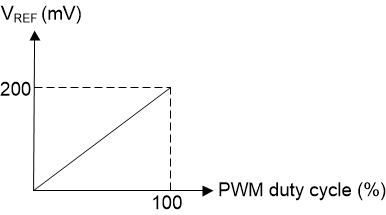SLUSCO8B November 2016 – June 2018 TPS54200 , TPS54201
PRODUCTION DATA.
- 1 Features
- 2 Applications
- 3 Description
- 4 Revision History
- 5 Description (continued)
- 6 Pin Configuration and Functions
- 7 Specifications
-
8 Detailed Description
- 8.1 Overview
- 8.2 Functional Block Diagram
- 8.3 Feature Description
- 8.4 Device Functional Modes
- 9 Application and Implementation
- 10Power Supply Recommendations
- 11Layout
- 12Device and Documentation Support
- 13Mechanical, Packaging, and Orderable Information
Package Options
Mechanical Data (Package|Pins)
- DDC|6
Thermal pad, mechanical data (Package|Pins)
Orderable Information
8.3.5 Voltage Reference
The voltage reference system produces a precise ±2.5% voltage reference over temperature by scaling the output of a temperature-stable band-gap circuit when the PWM duty cycle is 100%. In PWM dimming mode, the voltage reference, VREF, is fixed at 100 mV. In analog dimming mode, VREF, is proportional to the duty cycle of PWM as shown in Figure 16.
